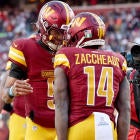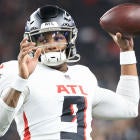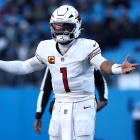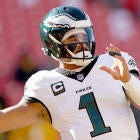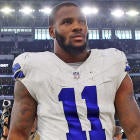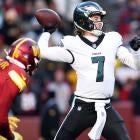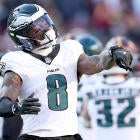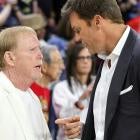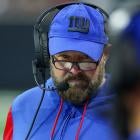
Scoring a lot of points usually results in a lot of wins. That was the case for many past Super Bowl winners. It was certainly the case for last year's Super Bowl champion, the Tampa Bay Buccaneers, who used their offense to help capture the franchise's second Vince Lombardi Trophy.
While there have been a slew of historic offenses over the NFL's 101-year history (specifically since the AFL-NFL merger in 1970), a few of those units truly left an indelible mark on the game in the years since their achievements. And while we may be living in the NFL's true passing era, that doesn't mean that the best offensive football resides in modern times. Instead, it appears that the 1990s, an era that saw a true balance of running and passing, produced some of the best offenses that have ever existed on a football field.
With the 2021 season just around the corner, we decided to take a look at the top ten offenses in league history. Along with scoring points, dominating opponents and fielding a unit with top-tier talent, you had to win a Super Bowl in order to make this cut, which is why you won't see the 1990s Bills "K-Gun" offense, Dan Fouts' Chargers, Peyton Manning's 2013 Broncos or either of Randy Moss' legendary offensive units (the '98 Vikings and '07 Patriots) on this list. If the ring is truly the thing, you had to win it all to earn a place on this all-time list.
Honorable Mention: 1991 WFT
Devoid of big-name players, Joe Gibbs' offense was not short on fire power in 1991. Gibbs' offense featured five Pro Bowlers in quarterback Mark Rypien, running back Earnest Byner, receiver Gary Clark, left tackle Jim Lachey and right guard Mark Schlereth. The offense also featured Hall of Fame receiver Art Monk, fellow receiver Ricky Sanders, running backs Ricky Ervins and Gerald Riggs, and right tackle Joe Jacoby, a member of the NFL's All-Decade Team for the 1980s.
Washington's offense averaged a league-high 30.3 points per game during the regular season. They scored 102 points in three playoff games, including 37 points in Washington's win over Buffalo in Super Bowl XXVI. Rypien won Super Bowl MVP honors after throwing for 292 yards and two touchdowns. Clark and Monk recorded 114 and 113 receiving yards, respectively, while the trio of Ervins, Byner and Riggs combined to amass 152 all-purpose yards and three touchdowns.

Pick Six Newsletter
Crafted By The Best NFL Experts
Get the day's big stories + fun stuff you love like mock drafts, picks and power rankings.
Thanks for signing up!
Keep an eye on your inbox.
Sorry!
There was an error processing your subscription.
10. 1976 Raiders
John Madden's offense boasted five future Hall of Fame players in quarterback Ken Stabler, receiver Fred Biletnikoff, tight end Dave Casper, left tackle Art Shell and left guard Gene Upshaw. The offense also featured receiver Cliff Branch (arguably the best player not currently enshrined in Canton, Ohio) and the formidable running back trio of Mark van Eeghen, Clarence Davis and Pete Banaszak.
The Raiders scored 24 points apiece in their playoff victories over New England and Pittsburgh, the defending two-time Super Bowl champs. Facing the Vikings' "Purple People Eater" defense in Super Bowl XI, Madden took full advantage of the left side of his line, which opened gaping holes for Davis to run for 137 yards on just 15 carries. All told, the Raiders rushed for a then-Super Bowl record 266 yards against one of the greatest defensive lines in league history. Oakland's offense line also provided plenty of time for Stabler, whose second-quarter touchdown pass to Casper jumpstarted the Raiders' attack. Biletnikoff became the second receiver to win Super Bowl MVP honors after catching three passes that set up Oakland touchdowns.
There's no better throwback this week than these five minutes of Coach Madden's Raiders dominating Super Bowl XI. #TBT
— Las Vegas Raiders (@Raiders) September 19, 2019
Full feature » https://t.co/mLxtXuII1W pic.twitter.com/CBASDl3S5p
9. 2020 Buccaneers
Despite some early growing pains, the Buccaneers' offense averaged nearly 31 points per game during the 2020 season. During their last seven games (including the postseason), Tampa Bay averaged 35 points per game. The Bucs scored at least 30 points in each of their four playoff wins that included a 31-point effort in their blowout win over the defending champion Chiefs in Super Bowl LV. Tom Brady won his fifth Super Bowl MVP award after throwing two touchdown passes to Rob Gronkowski and another to Antonio Brown. The Buccaneers' passing game was complemented perfectly by running backs Leonard Fournette and Ronald Jones II, who combined to gain 196 all-purpose yards and a touchdown on 32 touches. Fournette's 27-yard touchdown run in the third quarter gave the Buccaneers an insurmountable 28-9 lead.
Brady's primary target during the season was former Pro Bowl wideout Mike Evans, who caught 13 touchdown passes during his first season with Brady. Despite dealing with injuries, fellow receiver Chris Godwin finished second on the Buccaneers in receptions, receiving yards and touchdown catches. Scott Miller's 39-yard catch set up a key touchdown in Tampa Bay's win over Green Bay in the NFC Championship Game.
Protecting Brady during the Buccaneers' title run were Donovan Smith, Ali Marpet, Ryan Jensen, Alex Cappa and rookie first-round pick Tristan Wirfs. The unit allowed just three sacks of Brady during the Buccaneers' final three playoff games.
Tom Brady throwing TD passes to Gronk in the #SuperBowl
— NFL UK (@NFLUK) February 8, 2021
Some things never change.@Buccaneers. pic.twitter.com/roTr9f02Ye
8. 1994 49ers
With future Broncos head coach Mike Shanahan as offensive coordinator, the 49ers' offense was a cut above the rest in 1994. Led by league MVP Steve Young and Hall of Fame receiver Jerry Rice, the 49ers' offense averaged nearly 32 points per game during the regular season. San Francisco's offense also featured Pro Bowl running back Ricky Watters, fullback William Floyd, wideout John Taylor, Pro Bowl tight end Brent Jones and Pro Bowl linemen Jesse Sapolu and Bart Oates.
The 49ers' offense went into high gear during the playoffs. They scored 44 points on the Bears in the divisional round before lighting up the defending two-time champion Cowboys to the tune of 38 points in the NFC Championship Game. Those performances were just an appetizer for what was to come in Super Bowl XXIX. Young threw for six touchdown passes -- a still-standing Super Bowl record -- while also serving as the game's leading rusher. Three of Young's touchdown passes went to Rice, while Watters became the second player to score three touchdowns in the Big Game. Appropriately, the 49ers put up 49 points in their 23-point win over the Chargers.
On this #TBT we celebrate Steve Young's birthday by highlighting his performance in Super Bowl XXIX.
— NFL Films (@NFLFilms) October 11, 2018
Young threw a record six touchdown passes, the most by any QB in a Super Bowl!@49ers #GoNiners pic.twitter.com/1Rnrhqqtap
7. 2019 Chiefs
With reigning league MVP Patrick Mahomes under center, the Chiefs scored 51, 35 and 31 points in their respective playoff victories while becoming the first team in league history to overcome three consecutive double-digit deficits in a single postseason. Down 20-10 late in Super Bowl LIV, Kansas City scored three unanswered touchdowns against the 49ers' formidable defense. The comeback started when Mahomes hit Tyreek Hill on a 44-yard completion on a third-and-15 situation. It ended when running back Damien Williams (who scored the Chiefs' go-ahead touchdown) ripped off a 38-yard touchdown run.
The first player in league history to win Super Bowl and league MVP honors before his 25th birthday, Mahomes' main weapons on offense included Hill, Williams, Pro Bowl tight end Travis Kelce, and receivers Sammy Watkins, Mecole Hardman and Demarcus Robinson. Hill led all receivers with 105 yards in Super Bowl LIV, while Watkins and and Kelce each came up with big plays during the Chiefs' late scoring spree.
While devoid of Pro Bowl representation, the Chiefs possessed a solid offensive line that included Eric Fisher, Austin Reiter, Mitchell Schwartz, Laurent Duvernay-Tardif, Andrew Wylie, and Stefen Wisniewski. Fullback Anthony Sherman provided a key block that helped free Williams on his game-clinching touchdown run.
.@PatrickMahomes finding @sammywatkins in the 4th quarter wasn’t just the #NFLTurningPoint of @SuperBowl LIV, it was the dagger that put the league’s top defense to rest. pic.twitter.com/bbmu5dvuO5
— NFL Films (@NFLFilms) February 7, 2020
6. 1972 Dolphins
The undefeated '72 Dolphins boasted the league's best defense as well as the league's highest scoring offense. Running behind a talented offensive line that included Hall of Fame right guard Larry Little, left guard Bob Kuechenberg, Pro Bowl right tackle Norm Evans and center Jim Langer, running backs Larry Csonka and Mercury Morris became the first set of teammates in league history to each rush for over 1,000 yards in a season. The duo was complemented by fellow running back Jim Kiick, who scored three touchdowns during the postseason, including two against Pittsburgh's "Steel Curtain" defense in the AFC Championship Game en route to Super Bowl VII.
The Dolphins' passing attack featured Hall of Fame quarterback Bob Griese and fellow quarterback Earl Morrall, who earned All-Pro honors that year while winning all 10 of his starts with Griese out with an injury. Marv Fleming and Jim Mandich proved to be a formidable duo at tight end, but Miami's biggest threat in the passing game was Hall of Fame receiver Paul Warfield, whose 52-yard reception helped turn the tide in Miami's AFC title game victory over Pittsburgh. Miami's offense would help the Dolphins win back-to-back Super Bowls while becoming the first team to make three consecutive appearances in the Big Game.
The only undefeated team in @NFL history.
— Miami Dolphins (@MiamiDolphins) November 16, 2019
The 1972 Miami Dolphins have been named the greatest team by the @NFL! #NFL100 #FinsUP pic.twitter.com/XMmwd6y1w0
5. 1989 49ers
The '84 49ers initially held this spot, but after some debating, I ultimately gave the nod to the '89 49ers for several reasons. The 49ers' '84 offense -- a unit that overwhelmed the Dolphins' "Killer B" defense in Super Bowl XIX after besting the next two Super Bowl champions (the Bears and Giants) in the NFC playoffs -- had a better rushing attack, led by Roger Craig (1,324 total yards, 10 touchdowns) and Wendell Tyler (1,262 rushing yards, seven touchdowns, 5.1 yards per carry). They also had a very formidable receiving corps, led by receivers Dwight Clark (16.9 yards per catch) and Freddie Solomon (10 touchdown receptions) along with tight ends Earl Cooper and Russ Francis. The '84 49ers also had Hall of Fame head coach Bill Walsh, the architect of the West Coast offense, an offensive philosophy based on timing, precision and execution.
While they no longer had Walsh (who retired after the 49ers won Super Bowl XXIII), the '89 49ers had offensive coordinator Mike Holmgren, who later served as head coach when the Packers defeated the Patriots in Super Bowl XXXI. The '89 49ers still had Craig and quarterback Joe Montana, who completed over 70% of his passes that year while earning All-Pro honors. Along with having Super Bowl XXIII hero John Taylor at receiver, the '89 49ers' biggest advantage in this comparison is Jerry Rice, who came to San Francisco mere months after the 49ers beat up the Dolphins in the Super Bowl. The '89 49ers offense also had quarterback Steve Young, who won all three of his starts during the regular season.
In '89, the duo of Rice and Taylor combined to catch 142 passes for 2,560 yards and 27 touchdowns. San Francisco's passing attack was also buoyed by fullback Tom Rathman (73 catches, 616 yards) and Brent Jones (40 catches, 500 yards and four touchdowns). Craig, the first player in league history to run and catch for over 1,000 yards in a season, amassed 1,527 all-purpose yards during the regular season. San Francisco's talented offensive line included Pro Bowl left guard Guy McIntyre, center Jesse Sapolu, and tackles Harris Barton and Bubba Paris.
The 49ers' offense had arguably the best three-game run of any team in NFL playoff history. After scoring 71 total points in their playoff wins over the Vikings and Rams, San Francisco put on a clinic against the Broncos in Super Bowl XXIV. Led by Montana's five touchdown passes, the 49ers scored a Super Bowl record 55 points while recording the largest margin of victory (45 points) in Super Bowl history. Montana became the first player to win three Super Bowl MVP awards, while Rice's three touchdown receptions still hold the single-game Super Bowl record, a record he matched five years later in Super Bowl XXIX.
.@JoeMontana + @JerryRice + three other Hall of Famers.
— NFL (@NFL) November 17, 2019
The 1989 @49ers were STACKED. #GoNiners
📺: #NFL100 GREATEST SERIES | Continues next Friday 8pm ET on @nflnetwork pic.twitter.com/lEHp0p0kpJ
4. 1979 Steelers
The '79 Steelers were the epitome of high risk, high reward. While the '79 Steelers led the NFL in turnovers, they also led the league in points scored while featuring five Hall of Fame players in quarterback Terry Bradshaw (the reigning league and Super Bowl MVP), running back Franco Harris (1,477 total yards, 12 touchdowns), center Mike Webster, and receivers Lynn Swann and John Stallworth. Despite their turnover woes, Pittsburgh still managed to score 53 touchdowns, a franchise record that stood for nearly 40 years. The success of the offense allowed the Steelers to win their fourth Super Bowl in a six-year span while solidifying their place as arguably the best team of the Super Bowl era at the time.
While Bradshaw, Harris (the Steelers' career rushing leader) and Swann (the MVP of Super Bowl X) were already household names, the star of the '79 Steelers' offense was Stallworth, who lived in Swann's shadow during the first four years of his career before enjoying a breakout season in '78 that was capped off by his two-touchdown performance in Pittsburgh's win over Dallas in Super Bowl XIII. In '79, Stallworth picked up where he left off as he led the Steelers in receptions, yards and touchdowns while winning the team's MVP award. Against the Rams in Super Bowl XIV, with the Steelers trailing late and Swann sidelined with a concussion, Stallworth's 73-yard touchdown gave Pittsburgh the lead. His 45-yard catch on the Steelers' next possession set up Harris' game-clinching score.
Despite Stallworth's late heroics, the MVP of Super Bowl XIV went to Bradshaw, who also threw a 47-yard touchdown pass to Swann earlier in the game on his way to throwing for 309 yards. Bradshaw, who called Pittsburgh's plays in the huddle during each of its four Super Bowl wins, was also aided by a talented duo at tight end in Bennie Cunningham and Randy Grossman. Along with Bradshaw and Harris, the Steelers' backfield also included Rocky Bleier, who provided stellar blocking for Harris while also proving to be solid option as a runner and receiver, and Sidney Thornton, who ran for six touchdowns that season while averaging five yards per carry. Along with Webster, Pittsburgh's offensive line featured some of the best in the business in tackles Larry Brown and Jon Kolb and guards Sam Davis and Steve Courson.
After defeating the Rams in Super Bowl XIV, the 1979 #Steelers became the first team ever to win four Super Bowl championships.
— Pittsburgh Steelers (@steelers) November 9, 2019
Our 1979 team comes in at no. 39 on the #NFL100 Greatest Teams countdown. pic.twitter.com/4MSWfQYXN6
3. 1998 Broncos
Fresh off the franchise's first-ever Super Bowl win, the '98 Broncos featured an explosive offensive attack led by Hall of Fame running back Terrell Davis, who claimed league MVP honors after becoming only the fourth player in history to rush for over 2,000 yards in a season. Davis set an NFL record for the most yards ever gained by a running back during the regular season and postseason, rushing for 2,476 yards that included 199-, 167- and 102-yard rushing performances during the playoffs. Davis would have broken Eric Dickerson's regular-season rushing record had he not been pulled from a considerable amount of games during the season after the Broncos had mounted sizable leads.
Denver's '98 offense also featured Hall of Fame quarterback John Elway, who, despite being in his 16th and final NFL season, was still more than capable of leading the Broncos' offense to victory when defenses zeroed in on Davis. Trailing the Jets 10-0 in the AFC Championship Game, Elway's 47-yard completion to receiver Ed McCaffrey (father of Panthers' All-Pro running back Christian McCaffrey) ignited the Broncos, who scored the game's final 23 points. In Super Bowl XXXIII, with the Falcons' defense watching Davis' every move, Elway took full advantage, hitting Pro Bowl receiver Rod Smith for an 80-yard touchdown that gave the Broncos a 17-3 second quarter lead. Elway, who threw for 336 yards in his final NFL game, also rushed for a touchdown while earning MVP honors.
The '98 Broncos' offense included two 1,000-yard receivers in Smith and McCaffrey. It also featured Hall of Fame tight end Shannon Sharpe, who is second in franchise history in career receptions and third in touchdown catches. Denver's offense also boasted a vastly underrated offense line, led by left guard Mark "Stink" Schlereth, center Tom Nalen, left tackle Tony Jones, right guard Dan Neil and right tackle Henry Swyane. While they weren't the biggest of lines, Denver's front five help pry open devastating holes for Davis, who excelled in Mike Shanahan's zone running system. The line also provided sturdy protection for Elway and backup quarterback Bubby Brister, who went 6-0 as a starter when Elway was sidelined by an injury during the regular season.
“We knew in order to be special, we needed to repeat.”
— Denver Broncos (@Broncos) November 16, 2019
Our 1998 world championship team checks in at No. 14 on the #NFL100 list of Greatest Teams! pic.twitter.com/ifTkpOlAxN
2. 1995 Cowboys
Like the 49ers, the 1990s Cowboys had a couple of legendary offenses to choose between. Ultimately, the '95 Cowboys edged out the '92 unit for a few reasons, mostly because, by this point, the Cowboys' offense had developed into a well-oiled machine whose biggest opponent was not the opposition but themselves. If you want to watch the '90s Cowboys' offense at its height for a full 60-minute game, watch Super Bowl XXVII, when Dallas' offense helped put up 52 points on the helpless Bills. But if you really want to see the true excellence of that era of Cowboys' football, watch the first three possessions of Super Bowl XXX, when Dallas' offense ran through the Steelers' formidable defense like a hot knife through butter. But after scoring on each of its first three drives, an injury to Emmitt Smith neutered Dallas' offense for the remainder of the game; it was two interceptions by Larry Brown that set up both of the Cowboys' second-half touchdowns.
While Smith's injury prevented them from putting an exclamation point on their work, the '95 Cowboys' offense was, nevertheless, one of the most dominant units in league history. The engine was Smith, who earned All-Pro honors for a fourth straight season after rushing for a career-high 1,773 yards. He also rushed for a then NFL single-season record 25 touchdowns. In the playoffs, Smith scored six more touchdowns that included two against the Steelers, who allowed just nine rushing touchdowns during the regular season.
Smith was part of a trio famously known as "The Triplets" that also includes receiver Michael Irvin and quarterback Troy Aikman. Irvin, one of the most physical receivers in league history, set career highs with 110 receptions for 1,603 yards while also catching 10 touchdowns. Aikman, who has also received a gold jacket along with a bronze bust in Canton, Ohio, earned his fifth of six consecutive Pro Bowl honors that season. While the focus of the offense was centered on Smith, Aikman's steady play under center allowed the Cowboys to score 30, 28 and 27 points in their respective games during the '95 postseason. He was his typical efficient self in the NFC title game. While his counterpart that day, Brett Favre, threw for more yards with one more touchdown pass, Aikman completed a higher percentage of his passes, threw no interceptions (compared to Favre's two picks) while posting a 107.5 passser rating to Favre's 84 rating.
The Cowboys' offense was more than just "The Triplets." The '95 unit also featured fullback Darryl "Moose" Johnston, tight end Jay Novacek, receiver Kevin Williams and Hall of Fame cornerback Deion Sanders, who also saw time at receiver that season. Sanders' 47-yard catch in Super Bowl XXX set up the game's first touchdown, a short pass from Aikman to Novacek. The Cowboys' offense also included "The Great Wall of Dallas," an offensive line that featured Hall of Fame guard Larry Allen, tackles Erik Williams and Mark Tuinei, center Ray Donaldson, and left guard Nate Newton. Dallas' Great Wall, the NFL's first line to average 300 pounds per player, paved the way for perhaps the greatest offense the NFL has ever seen.
On this date in 1995, the Dallas Cowboys' Emmitt Smith sets the NFL record of 25 touchdowns in a season against the Arizona Cardinals. pic.twitter.com/owtrg2qqKz
— Honest☘️Larry (@HonestLarry1) December 25, 2020
1. 1999 Rams
The 1999 Rams, nicknamed "The Greatest Show on Turf," featured some of the fastest, most explosive playmakers in the NFL. That season, Hall of Fame running back Marshall Faulk, who was acquired from the Colts during the offseason, became the second player in league history to reach 1,000 yards rushing and receiving in the same season. Receiver Isaac Bruce, who will receive a gold jacket and bronze bust in Canton later this summer as a part of the class of 2020, led the group with 12 touchdown receptions. Fellow receiver Torry Holt, a rookie that season, caught six touchdown passes, while Az-Zahir Hakim contributed with eight touchdown catches.
Hall of Fame quarterback Kurt Warner, who replaced an injured Trent Green during the preseason, enjoyed a Cinderella season, earning league MVP honors two years after completing a two-year stint as the Iowa Barnstormers quarterback in the Arena Football League. In all, the '99 Rams offense, a unit that also included Hall of Fame lineman Orlando Pace, scored 526 points while averaging a whopping 32.9 points per game. But it was the speed of their offense that truly left fans and opponents gasping for air. That speed enabled the Rams to score at least 30 points in 12 of their 16 regular-season games en route to a 13-3 record. The Rams carried their momentum into their divisional round playoff matchup with the Vikings. In a classic shootout, Warner completed all but six of his 33 attempts for nearly 400 yards and five touchdowns in the Rams' 49-37 win.
After needing a late touchdown by receiver Ricky Proehl to defeat Tony Dungy's Buccaneers in the NFC Championship Game, the Rams had little issue moving the ball against the Titans in Super Bowl XXXIV. They did, however, have issues scoring touchdowns, as St. Louis had to settle for three field goals while taking a 9-0 halftime lead. Warner and the Rams did hit pay dirt on their first possession of the second half, with Warner finding Holt in the end zone for a nine-yard score.
Following 16 unanswered points by the Titans, Warner authored one of the greatest plays in Super Bowl history: a 73-yard touchdown pass to Bruce that was delivered just before he was leveled by Titans All-Pro pass rusher Javon Kearse. The completion gave Warner the then-Super Bowl record for passing yards in a single game (414) while also giving the Rams their first Super Bowl win. While they weren't always great, the Rams' "Greatest Show on Turf" was great when they had to be, which is one of the enduring hallmarks of arguably the greatest offense pro football has ever seen.
"Right here… everything went slow motion for me." @IsaacBruce80 breaks down the game-winning touchdown from @kurt13warner in Super Bowl XXXIV. #TBT pic.twitter.com/EQZZgyYoPP
— Los Angeles Rams (@RamsNFL) February 21, 2020









